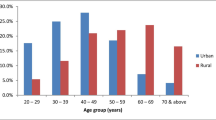Abstract
A total of 172 first degree relatives (FDRs) and 178 controls were included in this study. All the cases and controls were subjected to various anthropometric measurements, fasting and postprandial glucose estimation, fasting insulin measurement and fasting lipid profile. Results revealed the prevalence of Impaired Fasting Glucose (IFG) (cases 37% Vs controls 11.6%), Impaired Glucose Tolerance (IGT) (cases 34.3% Vs controls 11.2%) and diabetes (cases 11.05% controls 3.37%) was significantly higher in first degree relatives. Insulin resistance was measured using various methods, which included fasting plasma insulin (FPI), Homeostasis Model Assessment for Insulin Resistance (HOMAIR), insulin sensitivity index (ISI) (Mffm/l). Prevalence of insulin resistance (Insulin Resistance) as observed comparing FPI and HOMAIR in cases and controls was 43.6% and 11.24% (P=0.005) and 37.8% and 12.47% (P=0.000) respectively. Prevalence of IR (Insulin Resistance) observed in cases having Normal Glucose Tolerance (NGT), Impaired Fasting Glucose (IFG), Impaired Glucose Tolerance (IGT) and diabetes mellitus measuring FPI Vs HOMAIR was 37.5% vs 30.2%, 45% vs 40%, 38.98% vs 37.28% and 36.84% vs 31.57% as accordingly. However, ISI (Mffm/l) was not found to be a promising index for IR due to its poor specificity. Though HOMA is taken as gold standard for measurement of IR globally, our study observed fasting plasma insulin representing high sensitivity (89.7%) and specificity (93.3%) as compared to HOMA. Thus FPI had emerged in this work as a simple and reliable test for diagnosing insulin resistance across the population susceptible to develop diabetes including FDRs.
Similar content being viewed by others
References
National Diabetes Data Group (1979). Classification and diagnosis of diabetes mellitus and other categories of glucose intolerance. Diabetes 28, 1039–1057.
World Health Organization (1985) Diabetes mellitus: Report of a study group, Geneva, World Health Organization, (Tech.rep.Ser. No.727).
Report of the Expert Committee on the diagnosis and classification of Diabetes mellitus (1987) Diabetes care 20, 1183.
Implications of the United Kingdom Prospective Study (2001) Diabetes care, 24.
Olefsky, J.M. and Kolterman, O.G. (1982) Insulin action and resistance in obesity and non-insulin dependent diabetes mellitus. American Journal of Physiology 243, E15-E36.
Kirsten, a McAuley, Sheita, M.W. and Nick, J.L.B. (2001) Diagnosing insulin resistance in the general population. Diabetes care 4, 90–94.
Firth, R.G. and Bell, P.M. (1986) Effects of tolazamide and exogenous insulin on insulin action in patients with type-2 diabetes mellitus. New England Journal of Medicine 314, 1280–1286.
Scarlett, J.A., Gray, R.S. and Griffin, J. (1982). Insulin treatment reverse insulin resistance of type-2 diabetes mellitus. Diabetes Care, 5, 353–363.
Fujimoto, W.Y., Leonitti, D.L. and Kinyoun J.L. (1987) Prevalence of complications among second generation Japanese-American men with diabetes, impaired glucose tolerance or normal glucose tolerance. Diabetes, 36, 730–739.
Mastsude, M. and Defronzo, R.A. (1997)In vivo measurement of insulin sensitivity in humans. Clinical research in Diabetes and obesity 1, 23–65.
Masonori, Emoto and Yoshiki, N. (1999) Homeostasis model assessment as a clinical index of insulin resistance in Type-2 diabetic patients treated with sulfonylureas. Diabetes care 22, 818–822.
Matthews, D.R., Hosker, J.P. and Turner, R.C. (1985) Homeostasis model assessment: Insulin resistance and β-cell function fasting plasma glucose and insulin concentration in man. Diabetologia 28, 421–419.
Haffner, S.M., Miettinen, H. and Stem, M.P. (1997) The Homeostatic model in the San Antonio Heart study. Diabetes care 20, 1087–1092.
Volk, A and Ronn, W. (1999) Insulin action and secretion in healthy, glucose tolerance first-degree relatives of patients with Type-2 diabetes mellitus. Influence of body weight. Experimental and Clinical Endocrinology and Diabetes 107, 140–147.
Isomaa, B.O., Peter, A. and Kaj, Lathi (2001) Cardiovascular morbidity and mortality associated with the metabolic syndrome. Diabetes Care 4, 83–89.
Costa, A. and Rios, M. (1998) High prevalence of abnormal glucose tolerance and metabolic disturbances in first-degree relatives of NIDDM patients. A study in Catalonia, a mediterranean community. Diabetes Research and Clinical Practice 41, 191–196.
Tripathy, D., Carlsson, M. and Isomma, B. (2000) Insulin secretion and insulin sensitivity in relation to glucose tolerance; lessons from the Botnia study. Diabetes 49, 975–980.
Kwame, Earnest C.E. (1993) Serum insulin and glucose concentrations in people at risk for Type-II Diabetes. Diabetes Care 16, 1367–1375.
Author information
Authors and Affiliations
Corresponding author
Rights and permissions
About this article
Cite this article
Kumar, A., Tewari, P., Sahoo, S.S. et al. Prevalence of insulin resistance in first degree relatives of type-2 diabetes mellitus patients: A prospective study in north Indian population. Indian J Clin Biochem 20, 10–17 (2005). https://doi.org/10.1007/BF02867394
Issue Date:
DOI: https://doi.org/10.1007/BF02867394




